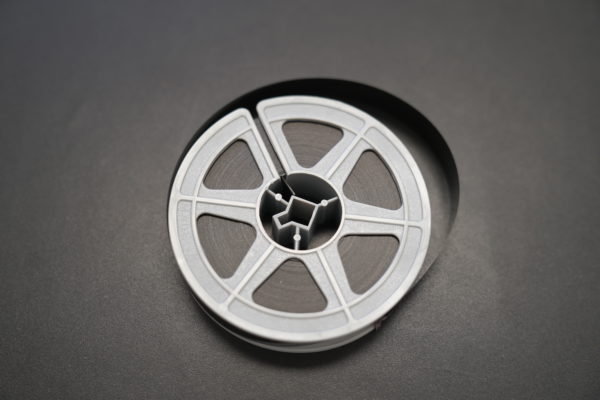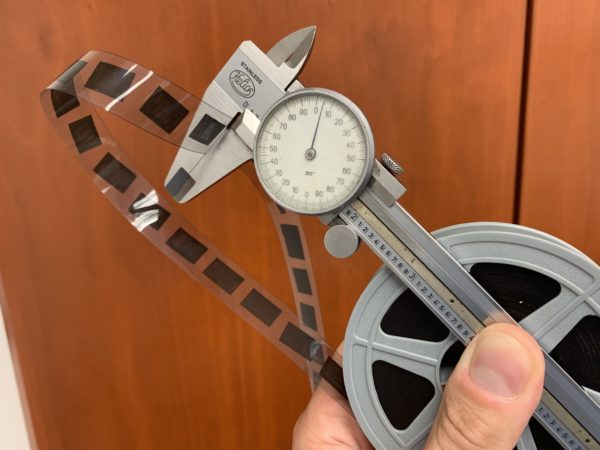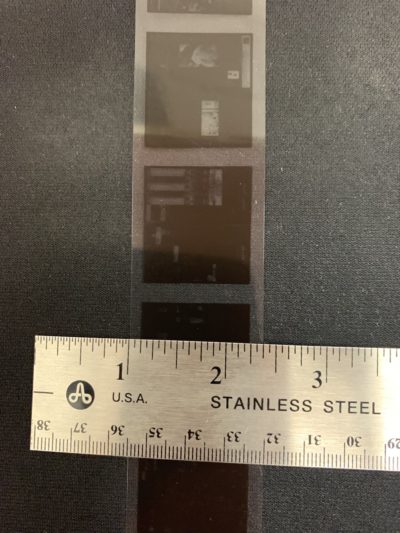Microfilm comes in different lengths?!
Yes it does, and you need to know which type you have if you’re going to be getting your microfilm scanned. Depending on how many rolls of 100’ or 215’ microfilm you get scanned, your project price can vary significantly because the two lengths require different levels of effort to digitize. At the most basic level, a microfilm reel that is twice as long as another is clearly going to require more labor, so you would expect the price to be a bit more.
But how do you tell which length of microfilm you have? Read on and find out!
If you’re more of a video person, click below to watch us describe
how you can determine which length of microfilm you have.
What Is Microfilm?
Microfilm is a record storage medium that is created by photographing documents and processing the images at a reduced size. By doing this, large quantities of images and vast amounts of data can be kept in a relatively small space.
When we say “microfilm,” we’re referring to the true owner of this name, the microfilm reel!

This is not to be confused with microfiche or aperture cards, although they’re often used interchangeably (and not correctly). They’re all related to microfilm, but the true type of microfilm is the type that comes in reels/rolls. If you’re not sure which type of record you have and want to find out, head over to our “what kind of film do I have?” page to see a bunch of pictures and descriptions.
How To Identify 100’ Microfilm
Calipers
No, we don’t expect many of you reading this article to have calipers. BUT, it might be worthwhile to purchase a caliper if you have a sizable microfilm collection because the difference in price between 100’ and 215’ rolls of film can be significant, so it’s good to know up front which type you have. You can find an inexpensive caliper for about $10-$20 on Amazon.
To measure your film using a caliper, you just squeeze the jaw of the tool on the flat part of the microfilm and get a reading. That’s it!
If the reading is 0.004”, then you have 100’ film, also called “thick” film.
100’ microfilm is called “thick” film because, as you’ll see when we get to the 215’ section, it’s caliper reading is larger than 215’ film; it’s thicker!

Caliper reading 0.004 on a roll of 100′ “thick” film.
Width
For 16mm microfilm, width will not help you determine if you have 100’ or 215’ film because both types are roughly ⅝” wide.
However, 35mm microfilm is about 1.5” wide, and only comes in the 100’ variety. So, if you use a ruler to measure the width of your film and notice that it’s 1.5”, then what you have is 35mm 100’ microfilm.

Ruler measurement of 16mm 100′ “thick” microfilm, coming in at about 5/8″.
35mm
As we mentioned above in the “Width” section, 35mm microfilm is always 100’ in length. If you have 35mm microfilm you can be sure that it’s 100’ and not 215’ long.

Ruler measurement of 35mm microfilm, coming in at about 1 1/2″.
Simplex
This method of identification is not an absolute, but is a starting point to determine which length of film you have.
If your microfilm images are simplex, meaning that the film has been created with one image per frame, then it’s likely that you have 100’ film. However, 215’ microfilm can also be simplex, so it’s not a surety; it’s more of a hunch.

Bend/Squeeze Test
Sticking with 16mm microfilm, since we know 35mm is going to be 100’, you can try a squeeze test to gauge the length of your film.
Pull out a little bit of film from the reel, and then give it a squeeze. If it takes a bit of pressure, sort of like bending an index card, then it’s probably 100’ “thick” film. If it gives way very easily, more like bending a standard sheet of printer paper, then you likely have 215’ “thin” film.
The best test is if you notice that two of your rolls feel different, and you squeeze test them at the same time: doing this will give you a very noticeable difference in pressure, and you’ll be able to tell right away which is 100’ and which is 215’ microfilm.
How To Identify 215’ Microfilm
Calipers
Using the same method as we did with the 100’ film test, take your caliper and squeeze the jaw of the tool on the flat part of the microfilm and get a reading.
If the reading is 0.0025”, then you have 215’ film, also called “thin” film.

Caliper reading 0.0025 on a roll of 215′ “thin” film.
Width
To reiterate from the earlier section: when you’re dealing with 16mm microfilm, width will not help you determine if you have 100’ or 215’ film because both types are roughly ⅝” wide.
But, if you have microfilm that is about 1.5” wide, then you have 35mm microfilm which is always 100’ in length.
Duplex
Looking at the actual images on the microfilm roll can give you an idea if your film is 100’ or 215’.
If your microfilm images are duplex, meaning that the film has been created with two images per frame, then it’s likely that you have 215’ film. However, 100’ microfilm can also be duplex, so it’s not a surety; it’s more of a hunch.

Bend/Squeeze Test
For 16mm film, since this type comes in both 100’ and 215’ lengths, we can use the bend/squeeze test to determine which type you have.
Pull out a little bit of film from the reel, and then give it a squeeze. If it takes a decent amount of pressure, similar to bending an index card, then it’s probably 100’ “thick” film. If it gives way easily, like bending a sheet of printer paper, then you probably have 215’ “thin” film.
The best test is if you notice that two of your rolls feel different, and you squeeze test them at the same time: doing this will give you a very noticeable difference in pressure, and you’ll be able to tell right away which is 100’ and which is 215’ microfilm.
Why Do I Need To Know If I Have 100’ Or 215’ Microfilm?
Scanning
If you plan on scanning your microfilm and converting the hard copies into digital images and data, the price between a 100’ roll of film and a 215’ roll of film can be significant. In most cases, the number of images on a 215’ is twice that of a 100’ roll. This should make sense, since the roll is physically twice as long!
Additionally, if the images were filmed in duplex, you could have four times the number of images. And if the reduction ratio of the filming is, say, 40x, you could have even more! We’ve seen rolls of 215’ film with 20,000+ images, so it can get pretty wild.
So knowing how many rolls in your collection are 100’ 215’ will be important to get an accurate project quote so that you can be prepared and make sure you have the funds to support the conversion.
For more details about microfilm scanning costs, check out our piece here.
Indexing
Indexing, or naming the digitized files, can be greatly affected depending on film being 100’ or 215’. Similar to the scanning section above, if you have 215’ microfilm then you’re going to have a much larger quantity of images.
Based on your indexing requirements, this can be a crucial factor. Let’s say you’re indexing your files at the roll-level. In this case, it doesn’t matter how many images are on a roll because no matter what, there’s only one index point to capture: the roll label!
But, if you want file-level indexing, then there can be a vastly larger quantity of index points. For instance, if the microfilm contains student records, and you want each student record individually indexed, you might have 600 individual files on a 100’ roll (which contains roughly 2,500 images). But if you have a 215’ duplex roll (roughly 6,000 images) then you might have around 1,500 individual files! This is a 3x increase in how many records have to be keyed and named for your final delivery, affecting your project cost.
Next Steps
Reach out to us today! Click the “Get Your Quote” button below, fill out the form, and we’ll quickly reply to you to discuss your project.
Further Reading
Check out a few of our other articles that cover various aspects of microfilm scanning and digitization:
“How Much Does Microfilm Scanning Cost?” describes the 9 factors that come into play when you get a price for your scanning project. Factors include the number of rolls that you get scanned, the type (such as 100′ or 215′!), and project timeline.
“The BMI Microfilm Scanning Process” details our 10-step scanning process that takes your microfilm from hard copy to digital records. Steps include transportation, creating a job order, and post-scan image processing.
“The Milestone 1 Proof Of Concept Process” is our method to create and test your project specs to ensure we’re giving you exactly what you asked for. Our Build, Test, Refine process ensures that we get it right and you get a successful project.

